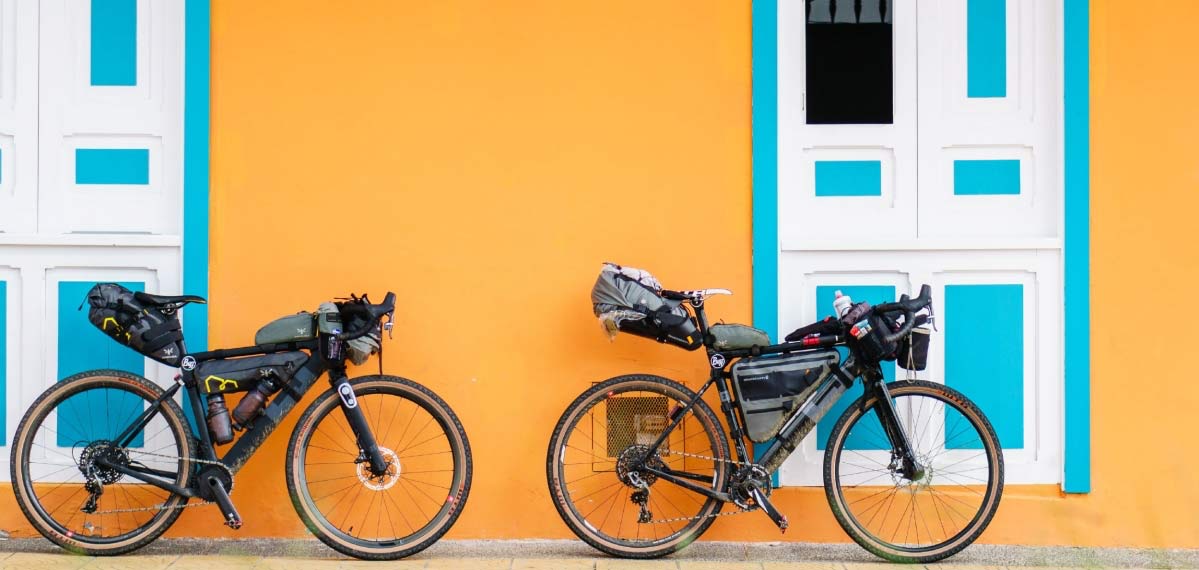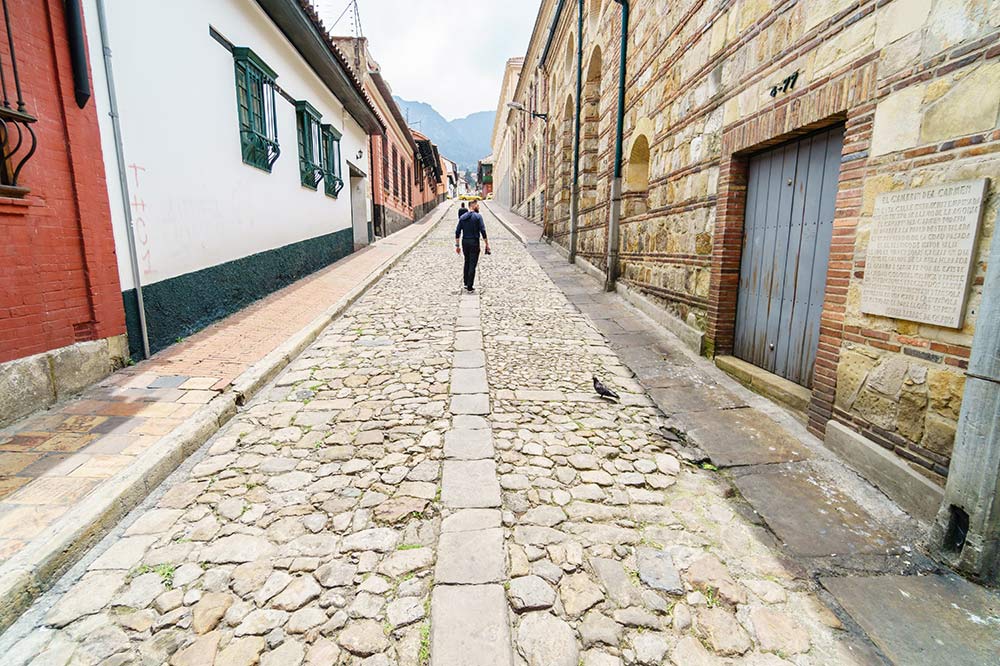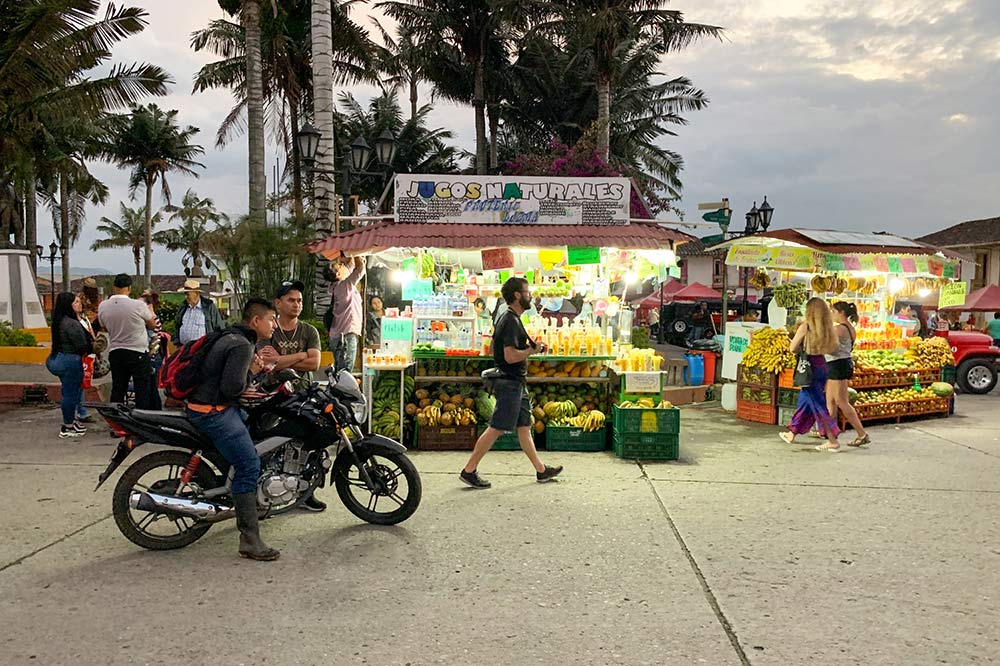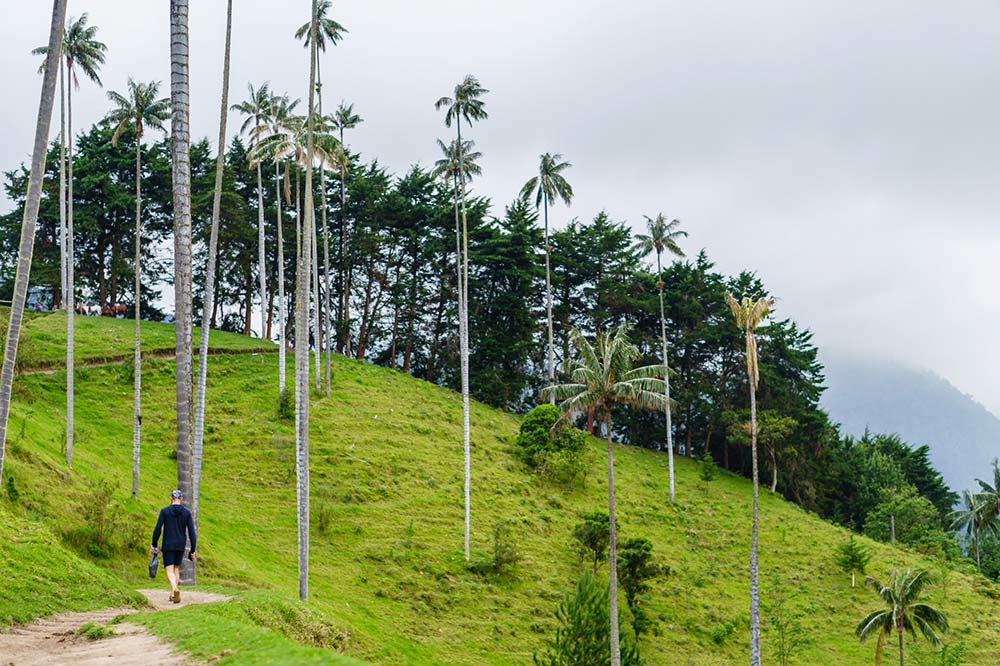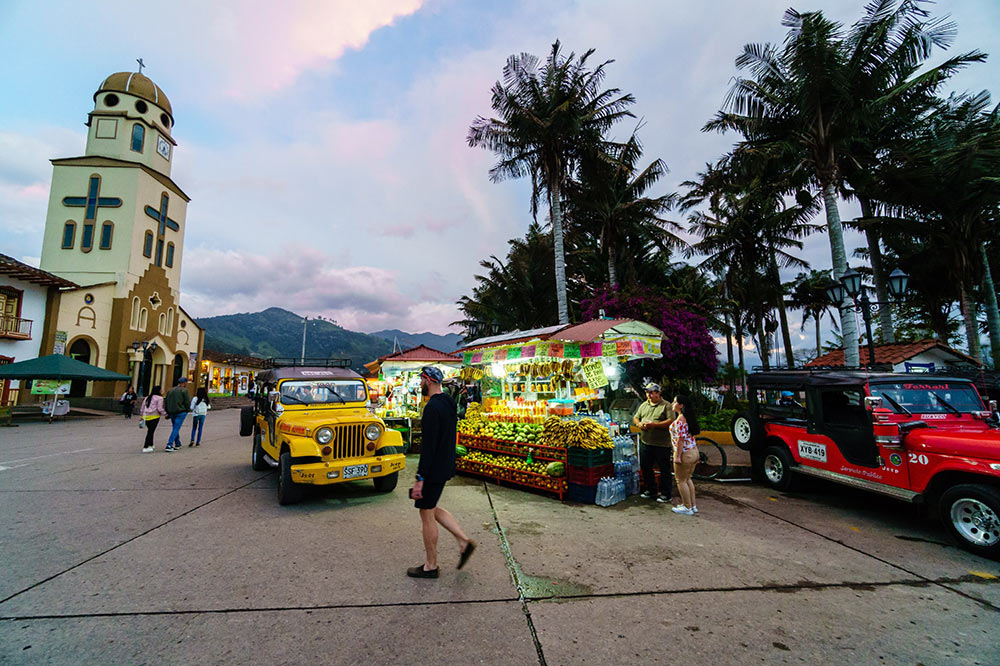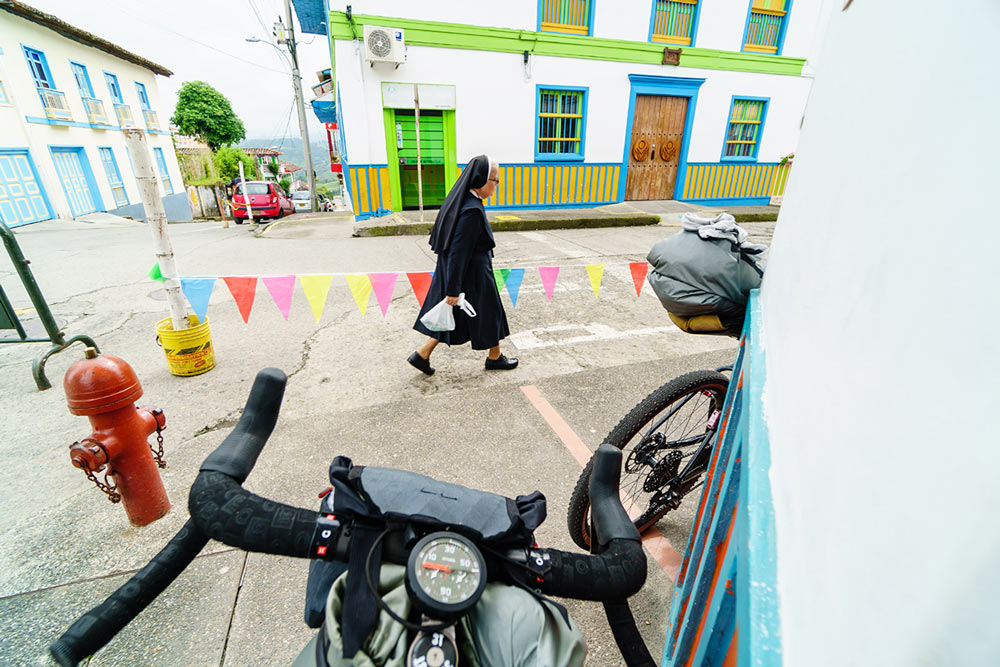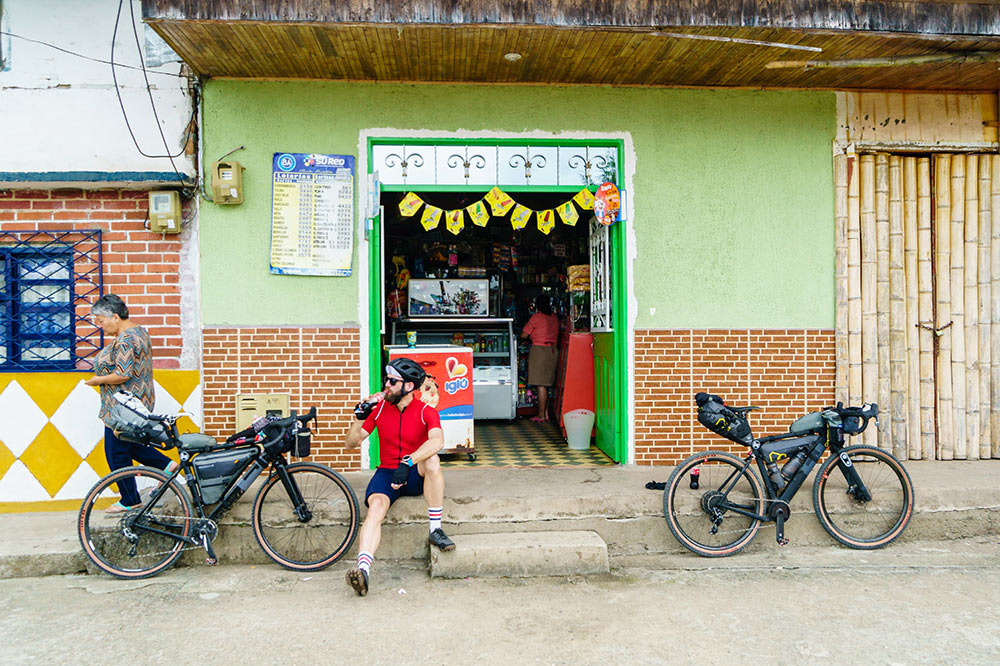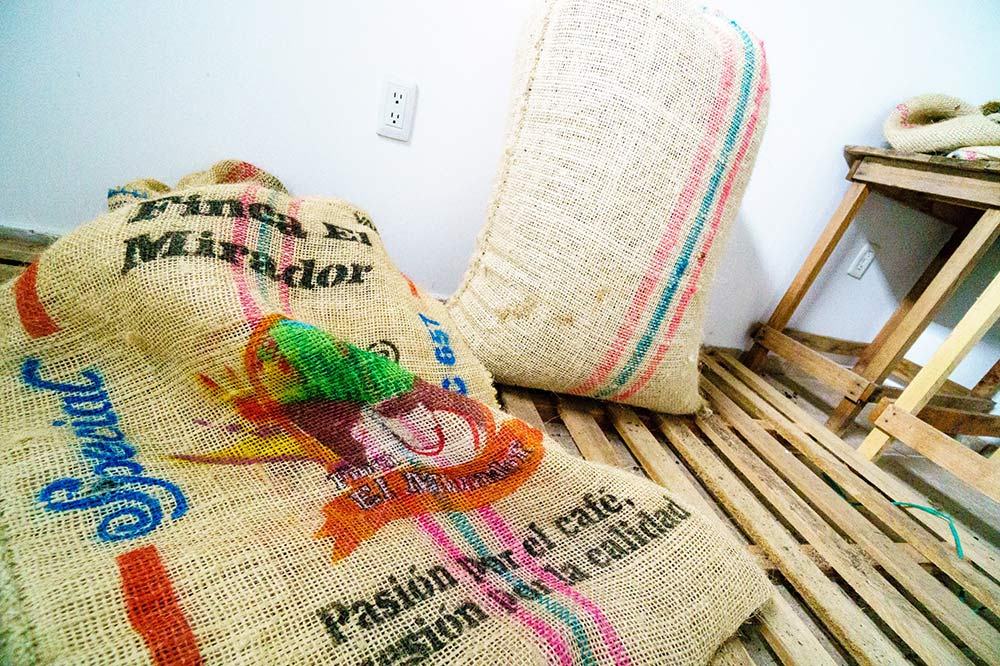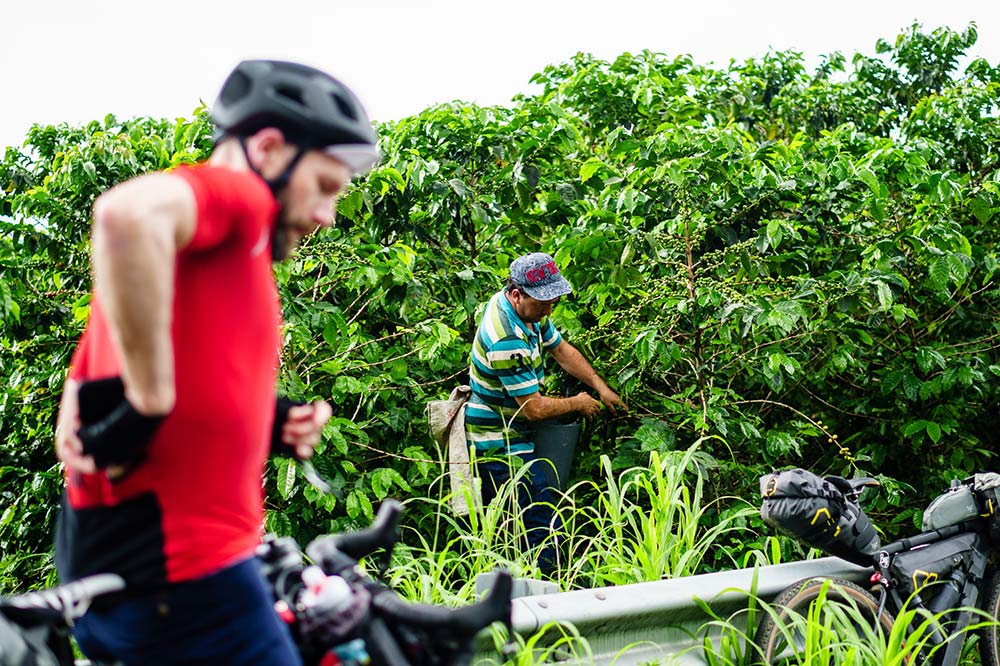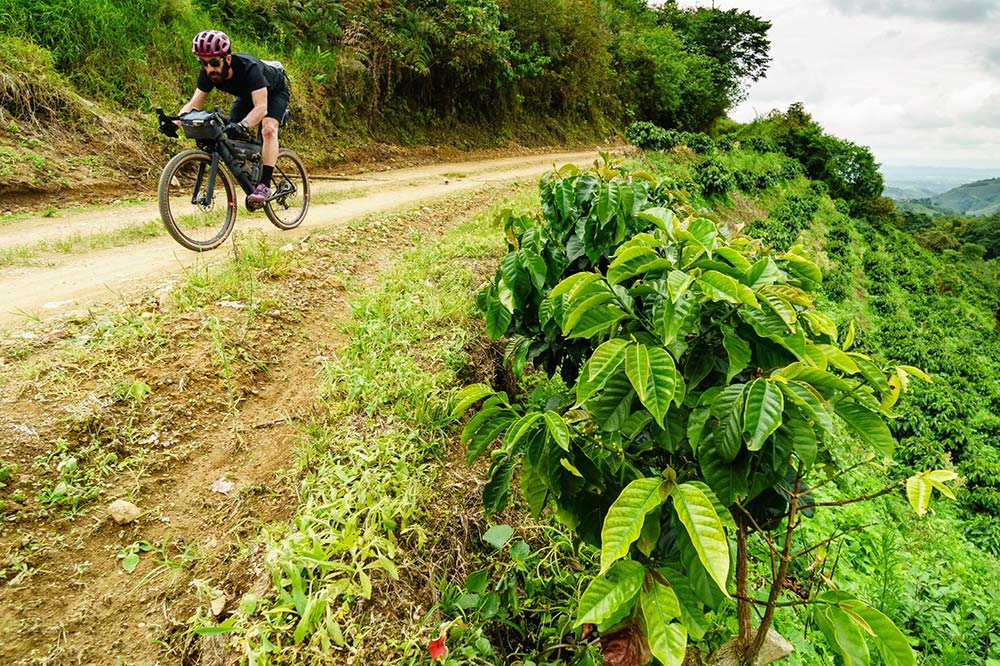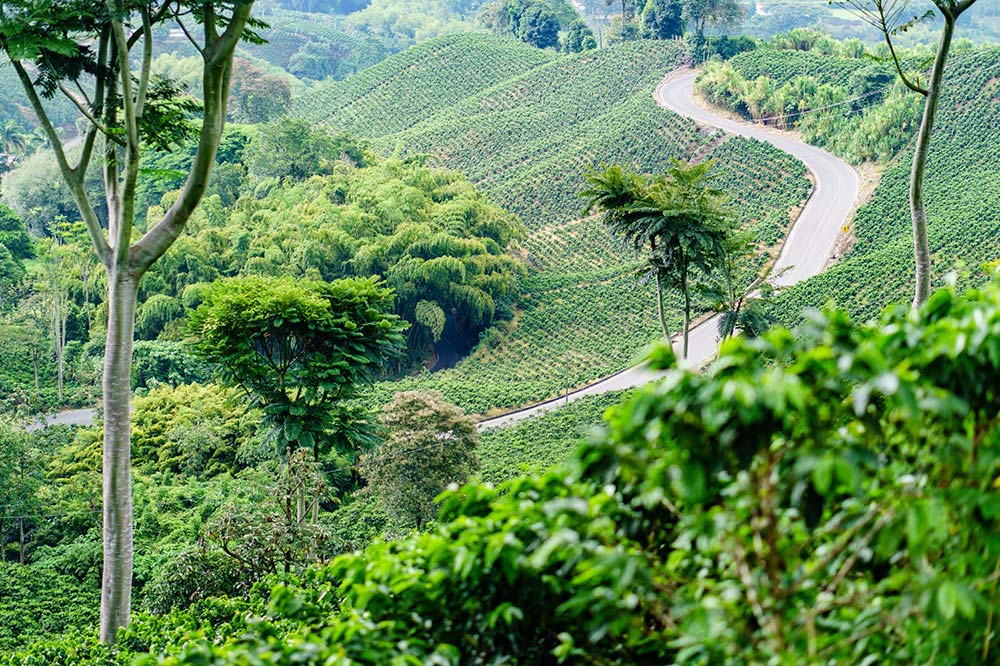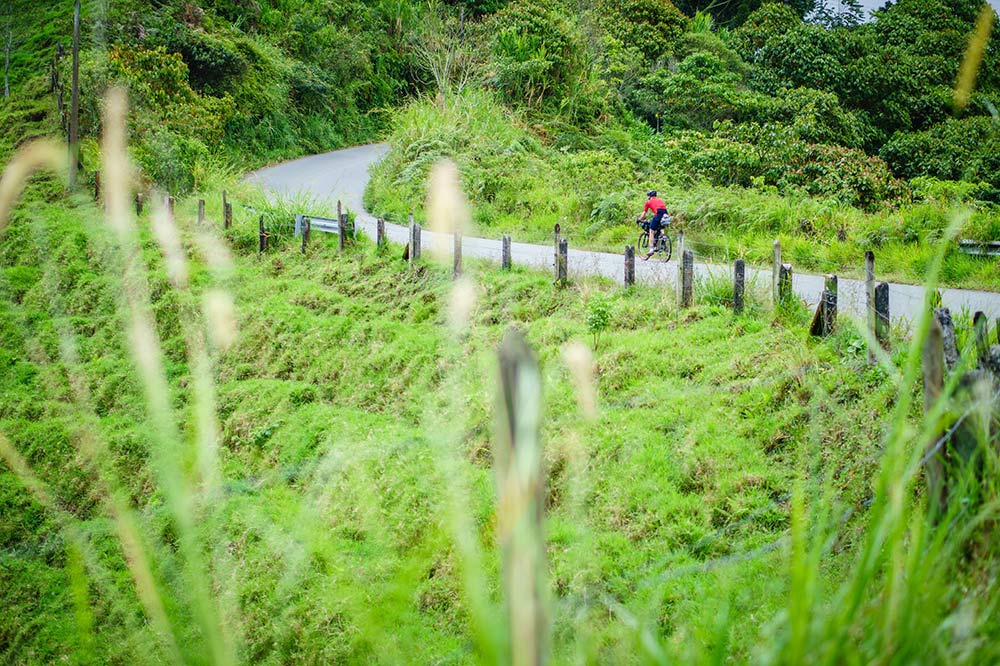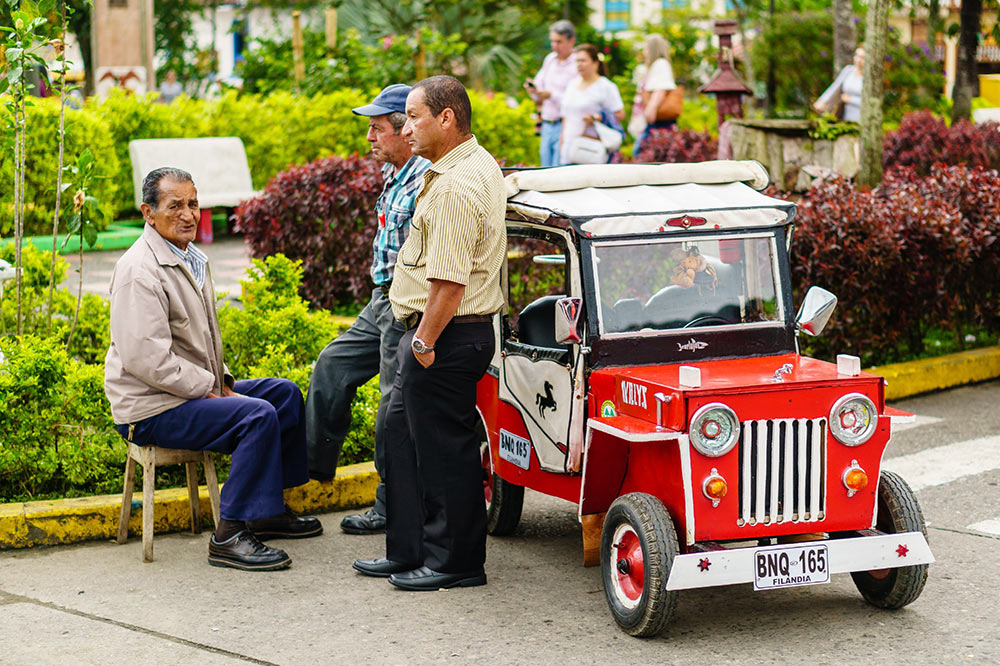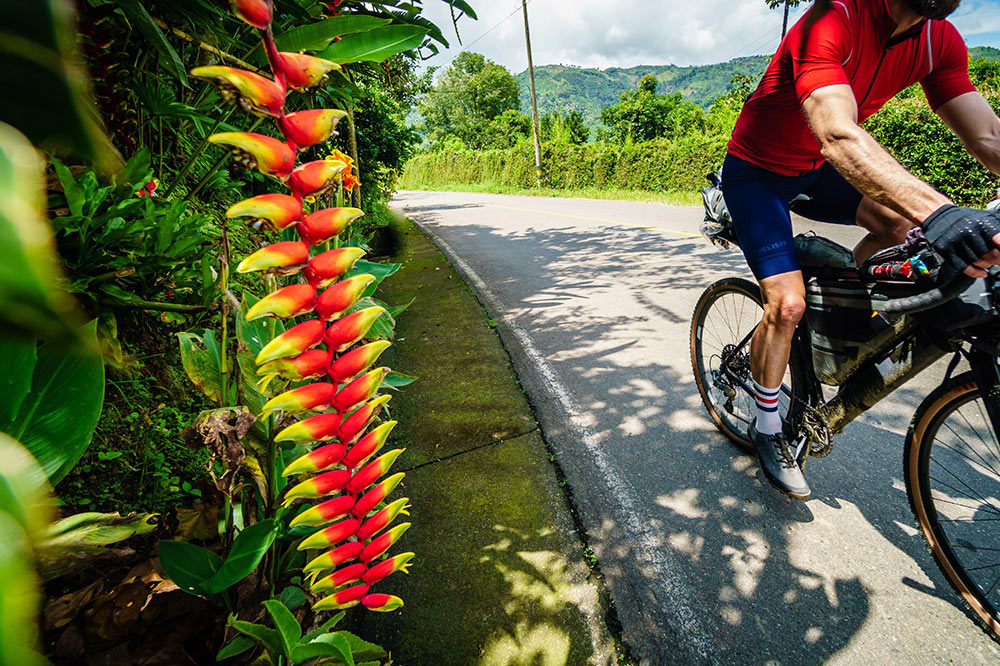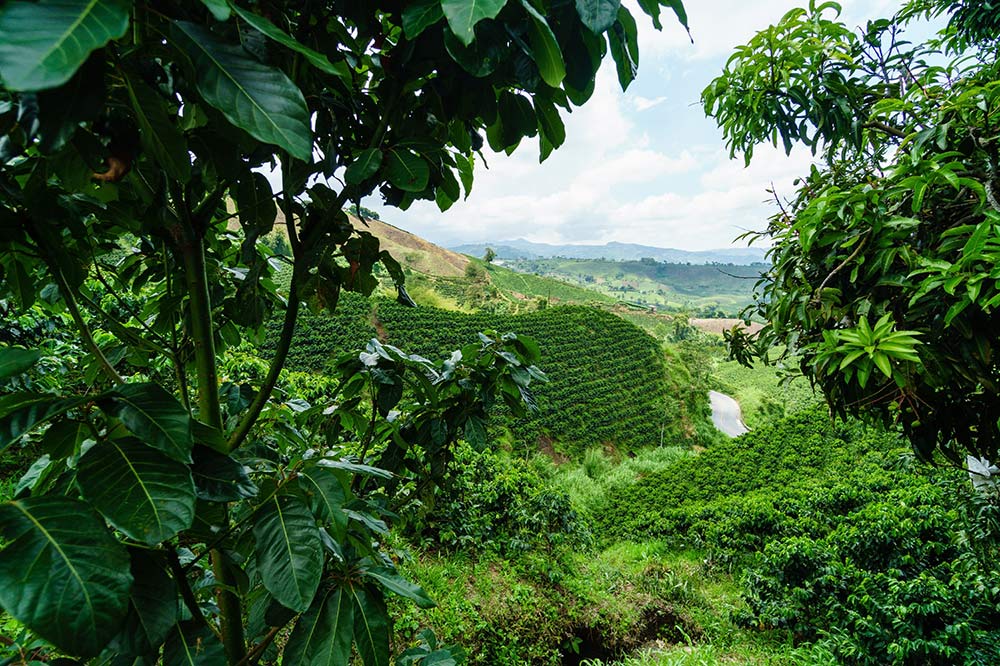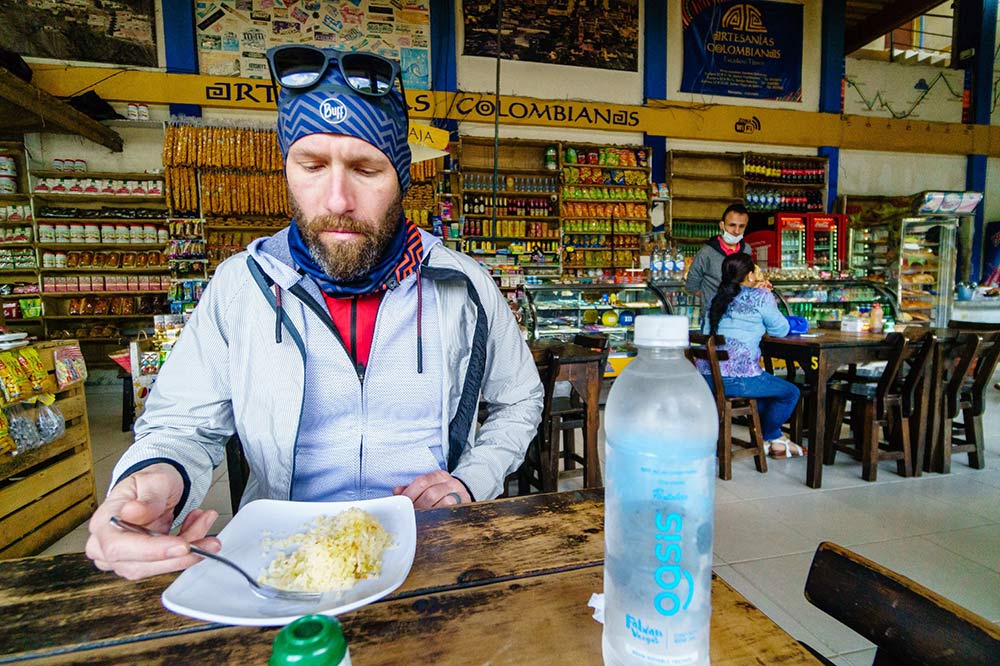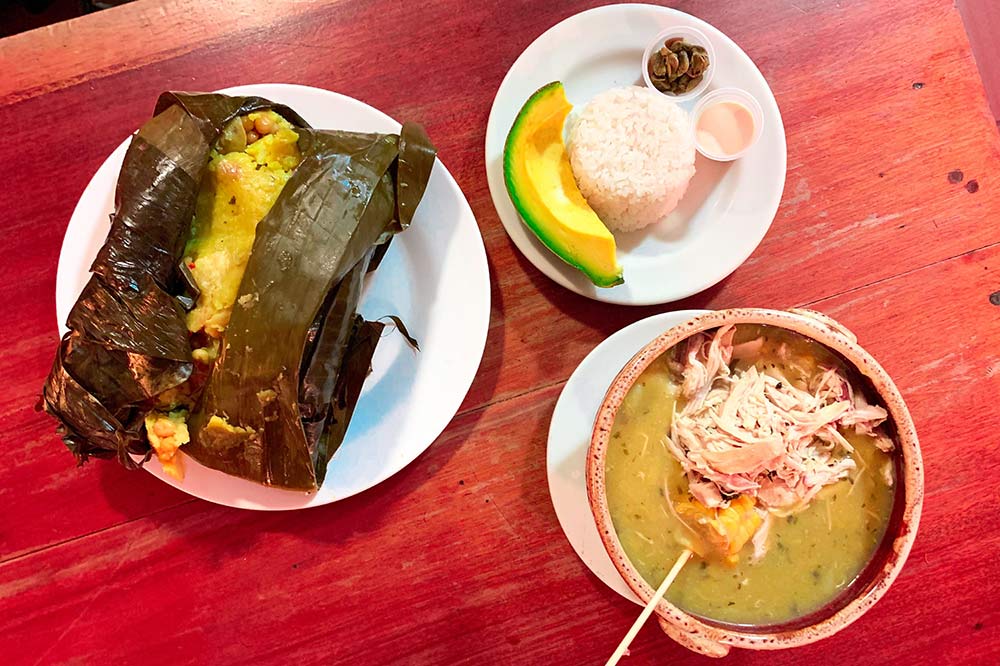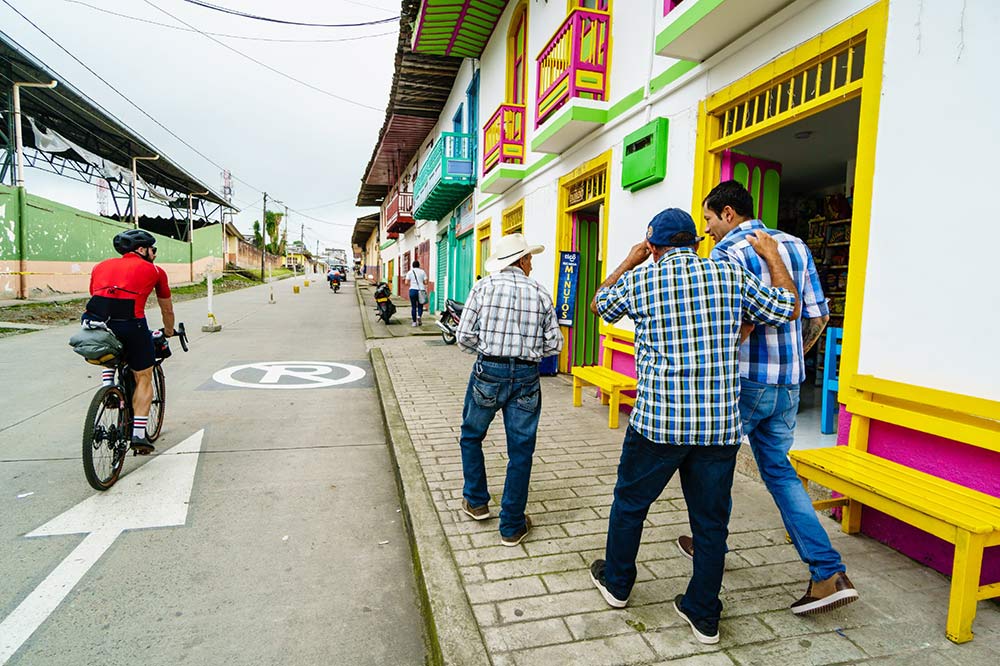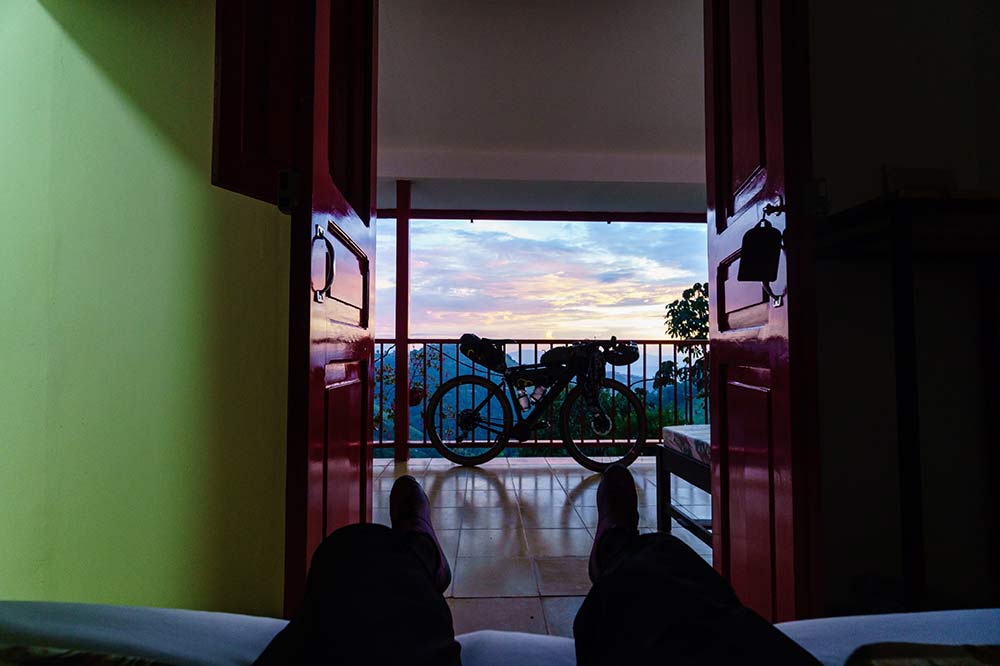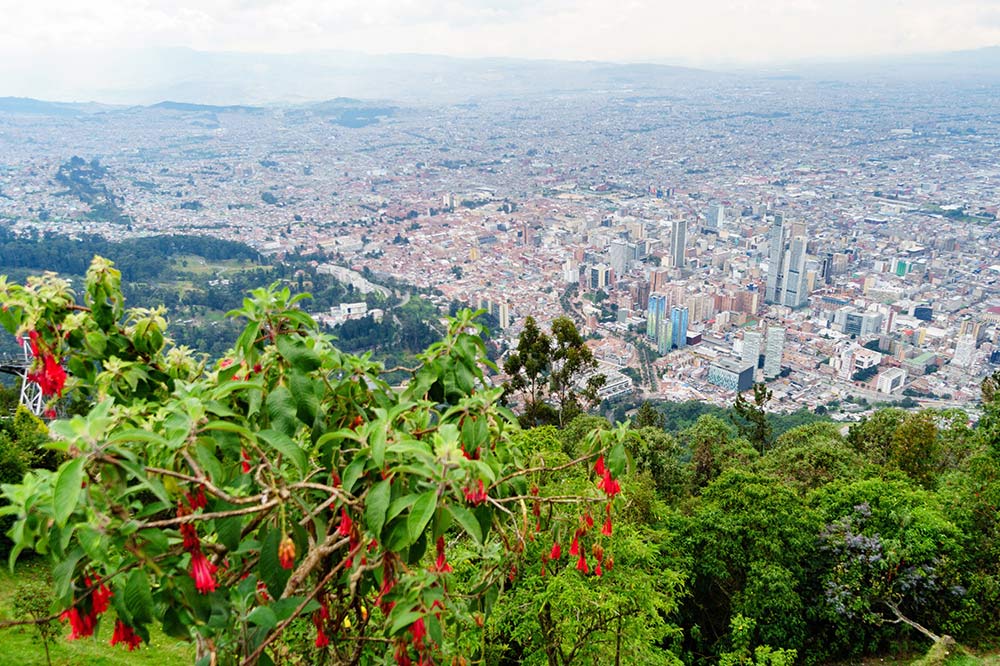Coffee, vintage 4×4’s, skyscraper palms trees and the best damn roads you may ever ride. The Andes of Colombia have all the ingredients for an exotic, far-flung adventure. This is why Colombia should be on every cyclists’ short list. Words by Steve Graepel, photos by Marc Gasch for XPDTN3.
I’ve never been a coffee connoisseur. I tossed coffee back by the 24 oz paper cup for the pick-me-up, not the flavor. Could just as well be siphoned from the office can, pumped at a gas station, or a five-spot cup of hipster brew excreted from the pits of cherries pooped out by feral cats. I was indiscriminate. And by now I could probably have paid for a year of my child’s education at some fancy private high school…all through the purchase of mediocre coffee. But that was then before I traveled to the equator to a place proudly distinguished as the Coffee Triangle.
Wedged between the Pacific and the Andes, and straddling just 5˚ North of the equator, sits a small plot of Colombian soil that is acidic (laden with volcanic ash spewed from nearby Nevado del Ruiz), with mild temps (a mean of 70, never hot, never cold … nearly always friendly to short sleeves and pants), and gets wet. Really wet. So wet, in fact, that the rain comes not once, but twice a year in April and October, dumping in sheets upwards of 3 meters of rain each year.
The yields of this trifecta? Near-perfect grounds for what some deem to be the very best coffee fruit in the world, the Coffea arabica.
But enough about the coffee (I’ll put it on the backburner … keep it fresh for later). I went to Colombia to explore backcountry roads by bike. Coffee would be a side sojourn, not the main event. But when traveling by bike, the sum is greater than the parts. And the parts, well in Colombia, they are pretty damn big, rich … silly vivid on every level. So if you have a hankering for some adventure, some real Romancing The Stone-type riding, here are some arguments to put a visit to Colombia’s Coffee Triangle near the top of your bucket list.
Valle de Cocora
Sitting at the south of the Coffee Triangle is the backpacking town of Salento. The colonial village is beautifully framed by the Cocora Valley, with houses accented in bright, pastel colors giving it heaps of old-world charm.
Yeah, it’s now discovered and trolled by young adults finding themselves while shopping for tchotchkes on the main street. But it’s still worth a visit. For no other reason than to explore the Seussian Valle de Cocora, where the 200’ Quindío wax palm grows naturally in forested stands.
Just getting to Cocora Valley is an adventure in itself. $3 will reserve you a spot on the back bumper of Jeep Willys, which packs folks in like a clown car (one Jeep can unbelievably fit up to 14 passengers).
While your attention is already gazing upwards, keep an eye out for the elusive and endangered Andean Condor and yellow-eared parrot, which nests in the tall, gangly palms. Spectacled bears, mountain tapirs, and puma haunt the forest shadows, too. All to say Valle de Cocora is completely otherworldly and jaw-dropping beautiful even to the most travel-jaded eye. And it’s why we chose to launch our journey out of Salento.
Rural Small Cities
The coffee region is triangulated by three major cities: Manizales, Armenia, and Pereira. Though each pleasant in their own way, it’s the backcountry villages that won our hearts.
Surrounded by lush, rolling green pastures and manicured plots of coffee stands, the Triangle’s smaller villages exemplify the heart and soul of the coffee axes culture. Filandia, Arabia and Marsella, these quaint towns sit at the tip-top of the hills (away from the torrential rains). Climbing into town, you roll into a Parque de Bolívar (or central park) lined with cafes, capitalized by a church, and coursing with vintage 4X4’s that pump people and supplies into the heart of each pueblo.
Taxi drivers wrench on Jeep Willys. Butchers shoulder slabs of beef. Geraniums pour out of window boxes by the bushels. Whaffs of fried empanadas intermingles with diesel fumes. Far from the bohemian boardwalk, this is real life, revealed slowly. Its authenticity draws you in and is at the root of the culture’s charm.
The Coffee
Here we are again. Though only taking up a small plot of Colombia’s real estate (the small departments making up the Coffee Triangle plot only 1% of Colombia’s land), the region produces nearly a third of the worlds coffee (behind Brazil and Vietnam). And not just any burnt bean, but what is often considered to be among the highest quality in the coffee world. Coffea arabica is a delicate berry that only flourishes at specific altitudes under-regulated temperatures, with precise sun, unique soil and buckets of rain. And it’s grown on steep hills … hills too steep to harvest by machine. Colombia fills over 11.5 million jute bags packed with ripe, red berries each year … and you got it, all of them stuffed with berries picked by hand.
Sure, you can still manage to get a poor cup of coffee in paradise. In fact, much of the Triangle’s beans are exported to North America and across the Atlantic to Europe. But the younger crowd caught a whiff of a good thing and great coffee can be found in abundance. Even in the smallest town.
Most of Colombia’s coffee plantations are small, family-run fincas (or farms). We made an impromptu visit to Finca El Mirador (which is currently closed to the public while being remodeled). Still, the staff threw opened the doors, handed us a cup of coffee and gave us the nickel tour. We were mesmerized by the rows of arabica and checked out the roaster and the sorting machinery. The estate has plans to reopen in December for tours and will even rent out a room for the night.
Even if you are a coffee slob (not a snob), simply taking the time to understand and appreciate the bean is something you can carry with you well into our next Starbucks visit. If you are interested in learning more about Colombia’s coffee industry, sign up for a coffee tour. Two active fincas sit just outside of Salento
-
- El Ocaso, a traditional family finca, sits 5 k outside of Salento
- For a more ‘authentic experience, check out Finca Don Eduardo.
The roads
What makes for good coffee, coincidentally, makes for some world class cycling. The roads to and from the fincas are spectacular, often paved (and smoothly so), overhanging with flowering Heliconia vines and choked with Birds of Paradise.
Trafficked only by Jeep Willys and the occasional commuter bus, the sleepy roads snake through steep hills draped in electric green, under stands of bamboo, eucalyptus, and plantain, interrupted with corrugated rows of coffee stands. Verdant, lush, electric, vibrant … technicolor. The hues of green could fill a library and exhausts the superlatives.
The Climbs
Colombia is for climbers. The Andean foothills are of mountainous proportions, with the king of the mountain ascending over 10,000’ inside 85 km. Alto de Letras is often lauded as the world’s longest climb. Pros crush it inside four hours, while mere mortals will struggle up it in seven. It’s no surprise that the Colombians have acquired a deep wardrobe stacked with polka dot jerseys.
The route we explored rolled-up short, punchy climbs … and long, spectacular grinds towards Marsella and Manizales. And for the true ascensionist, the final day tackles the world-class Alto de Letras (from the backside, on gravel), climbing through three ecosystems: tropical, cloud forest, and finally the treeless paramo plateau.
Unfortunately, the descents continually gobsmack you with views, forcing you to throttle the speed to a stop to snap off a few pictures.
#Carspotting
Yes, I lugged a bike to Colombia for the riding but was secretly conspiring to take in the cars. See, I love old 4X4’s. And Colombia has these in spades. FJ’s, Suzuki Samurais, Nissan Patrols, Series Land Rovers … the vintage 4×4 is in its natural habitat on the Colombian backroads. But the mechanical mule of choice? It’s undeniably the Jeep Willys. After World War II, the U.S. sold off its massive surplus of CJ Jeeps and the Colombian Ministry of Defense was quick to snatch up a fleet of the iconic 4X4. The reliable and easy to repair Jeep was quickly embraced by rural farmers who found the Willys an upgrade from the horse and cart that previously worked the front lines of agriculture.
Today, the iconic Willys is synonymous with the coffee region and are still commissioned to haul supplies, taxi rural residents, or cruise the strip at Yipao, the annual Jeep parade in Armenia that celebrates the “mulitas mecánicas,” or metal mule. A trip to the Coffee Triangle is not complete without hitching a ride in the back of a Jeep Willys.
Basic Background Information
Cycling is more than a mode of transportation in Colombia. Lycra and saddles are pursued with gusto and embraced by the cities. In fact, every Sunday since 1974, the capital city of Bogotá has closed 120 km of its streets to automobiles in favor of cyclists and pedestrians. The move was received with such success that both Medellín and Cali have adopted the weekly ciclovías.
But even during the week, the will to cycle is strong. It’s not uncommon to see fully kitted road cyclists training in the middle of five lanes of stop-and-go highway traffic … during heavy rainstorms.
Economy
Colombia’s chief exports are extracted from the earth: crude, coffee, minerals, flower and fruit. But I’d add to that list smiles. Everywhere we went, the people were smiling, happy to put aside the task at hand to share an experience, to show you around, or take an interest in what you were doing in a place so clearly far from your home. They likely won’t speak English, but they speak fluent humanity.
The Colombian Peso is 3000:1 USD (3500: €1). While hotels will often take a credit card, most restaurants and small retailers will need cash and small bills. You can exchange currencies at the airport. $500 should get you through a long week.
Weather
Because of its proximity to the equator, there is no true summer or winter. Instead, there are two dry seasons (December-January and July-August) and two wet seasons (April-May and October -November). And as they say, when it rains it pours (yes, nearly 10-feet of rain each year). The wet conditions make for IMAX quality backdrop, abundant with fruit, foliage, and the unique “star of water” palm (the tallest palm tree in the world). To appreciate the riding, plan your visit during (or on the shoulders of) the dry season.
Getting There
Traveling to Colombia is affordable, more so than traveling to Central America. Round trip to Bogotá can be found for under $1,000 from both Europe and the States.
From Bogotá, make arrangements to shuttle bikes to Salento and for a van to pick you up north, in Manizales. We parsed the 130-mile route over three days, increasing in intensity from flat to extreme climbs. We found three unique hotels that were both affordable and luxurious and parsed out the ride nicely.
Pro-tip: Consider climbing up and over Alto de Letras and have your shuttle meet you on the east side of the descent, in the small town of Murillo. And hold on tight, that descent can take riders three hours to drop 10,000’. Of course, this requires you haul all your gear up the climb from Manizales.
Where to Stay
Hotel Salento Real Eje Cafetero. $60. The Hotel Salento Real sits a few blocks off the bohemian boardwalk and offers large rooms and great food from the adjacent rooftop restaurant that overlooks Salento. Round trip ride to Valle de Cocora: $3.
Hotel Spa La Colina. $90.The hospitality is tops, the rooms are luxurious, and the food is sumptuous, only to be topped with amazing views. And since you’ve been in the saddle all day, after your soak in the hot tub, treat yourself to a message ($30). The cricket and thunder soundtrack? That’s no CD; it’s live streaming.
Paraíso Verde Manizales. $60. Originally a home for single mothers, the grounds were recently purchased privately and converted into an ecolodge. Only 3 km away from bustling Manizales, Paraíso Verde is tucked away in a steep valley overlooking the other direction, towards a lush cloud forest populated with the boldly colored toucan barbet. Paraíso Verde also puts you within a short taxi ride from the start of the storied Alto de Letras climb.
Hotel Virrey Park. Located close to the airport and a short walk or Uber ride from Bogotá’s hip neighborhoods, Virrey Park is a great place to catch your breath and acclimate. Check out the historic Plaza Bolívar, the young and trendy historic town, La Candelaria. Or take a short ride on a funicular to the top of Monserrate, for a five-star view of Bogotá. Remember, Bogotá sits at 8,600 feet, so drink plenty of water. A unique place to hit the well and stock up on protein is Andrés Carne de Res. The food is amazing, the environment is eclectic, and with 200 servers walking 4 floors of dining … it’s unlike any place we’ve ever dined.
In classic XPDTN3 style (3 days, self-supported, self-documented) we rode on bikepacking style, but we needed to get out of Bogotá first and reach the coffee region (long way, about 6-7 hours drive) We took a van shuttle from Bogotá to Salento with only our bikepacking packs loaded on the Exploros, left the rest of our stuff on the hotel in the capital, and rode all the way from Salento to Manizales. You can organize the transfer back to Bogotá to pick you up either on Mariquita after descending Letras, or at the top if you are too tired (even back at Manizales if you descend on the other side of the mountain)
Follow Our Route
Here’s our complete Komoot route, which you can add to your own Komoot account for free.
Like this story? Check out larger versions of these photos and more of them at 3T’s XPDTN3 portal.
